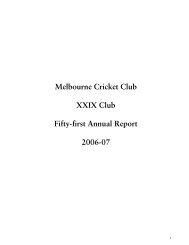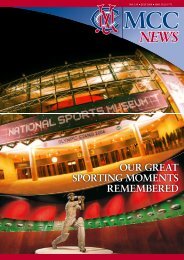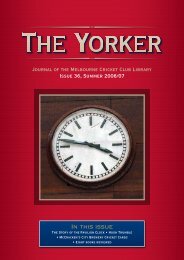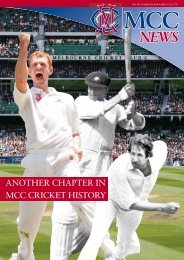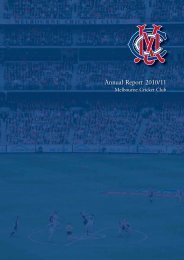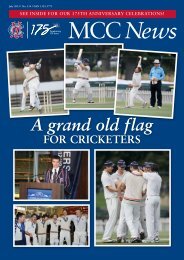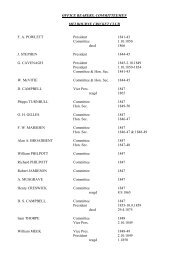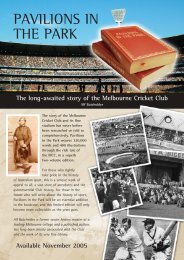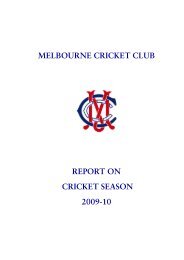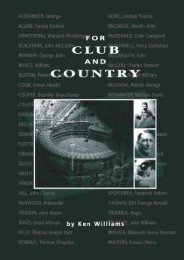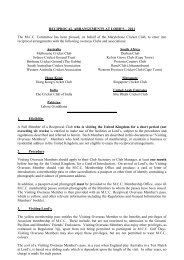Issue 42: Spring 2010 - Melbourne Cricket Club
Issue 42: Spring 2010 - Melbourne Cricket Club
Issue 42: Spring 2010 - Melbourne Cricket Club
Create successful ePaper yourself
Turn your PDF publications into a flip-book with our unique Google optimized e-Paper software.
For our spring <strong>2010</strong> issue we commemorate a centenary<br />
(of flight at the MCG), a passing (Major Everett Pope, the Medal<br />
of Honor winner based at the MCG in WWII) and an unveiling<br />
(of the MCC Archives). The <strong>Club</strong>’s archive was established as a<br />
separate heritage collection in April 2009 with the transferring<br />
of the corporate records collection to the L2 store room and the<br />
appointment of Patricia Downs as our first professional archivist.<br />
Patricia had extensive knowledge of the collections from her<br />
work on the MCC Museum inventory project, as a member of the<br />
National Sports Museum production team and on a digitisation<br />
project in the MCC Library. As part of her two year pilot project<br />
Patricia, assisted by an enthusiastic team of MCC Library<br />
This <strong>Issue</strong><br />
volunteers, has been sorting through the records uncovering a<br />
real treasure trove of primary source material. Access to the<br />
archives is closed while material is sorted and inventoried and<br />
we finalise the access policy. However, we take great pleasure<br />
in sharing some of these treasures with our readers, with three<br />
pieces helping to shed new light upon our club’s history. On the<br />
topic primary sources and research, our other feature article<br />
(starting this page) shows the importance of historians going<br />
back to check original sources themselves, as Roy Hay examines<br />
long-held myths on early football espoused by pioneer Australian<br />
Football historian Cec Mullen.<br />
The EDITORS<br />
Cec Mullen, Tom Wills<br />
and the search for early<br />
2<br />
Cec Mullen with his scrap books.<br />
Football Life, April 1969.<br />
Introducing Cec Mullen: Pioneer Sports Historian<br />
Clarence Cecil Mullen was born in Richmond in 1895. As a boy he gained an interest in football and<br />
“helped to bag grass and sell papers” at the <strong>Melbourne</strong>, East <strong>Melbourne</strong> and Richmond cricket grounds. 1<br />
Mullen's love of sports history developed further after he was employed by the Argus and a number of<br />
local Richmond papers and had access to their newspaper archives. 2<br />
By 1922, when he moved to<br />
Abbotsford, Mullen had developed<br />
strong interests in music, sport and<br />
local history. He regarded sport<br />
as a means of providing wider<br />
opportunities for underprivileged<br />
children and promoting an ethical<br />
approach to life in general.<br />
With these goals in mind,<br />
Mullen organised teams for<br />
Richmond boys, forming a<br />
non-denominational club<br />
that later evolved to include<br />
boys and girls from neighbouring suburbs. Among his protégés<br />
were footballers Laurie Nash, Tom Lahiff, Clarrie Vontom and Ron<br />
Richards, as well as Test cricketer Neil Harvey. 3<br />
Mullen’s passion for history and sport led him to become a football<br />
historian. Unlike other pioneers in that field (such as R.H. Campbell<br />
and Percy Taylor), Mullen dealt with the game’s deep history, its<br />
origins and early development. However, in working on this subject in<br />
the first half of the 20 th Century, he had few colleagues to assist him<br />
(one notable exception was W.L. Floyd). With limited access to primary<br />
resources and critique, Mullen made some basic historical errors.<br />
Modern scholarship has shown that his work contains many<br />
anomalies, such as phantom matches, anachronisms,<br />
exaggerations and omissions. Despite their inaccuracies, or<br />
perhaps because of them, Mullen’s Australasian Footballers'<br />
Almanac (1950), Mullen's Footballers’ Australian Almanac 1951,<br />
and his History of Australian Rules Football: 1858-1958, are<br />
fundamental to the study of football historiography.<br />
In addition to Mullen’s published material, the MCC Library has<br />
a large number of his unpublished works, including his History of<br />
the Essendon Football <strong>Club</strong> 1873-1907, notes on histories of various<br />
football clubs, Victoria’s Contribution to <strong>Cricket</strong> (Vols. I & II), and<br />
notes on women’s cricket in Victoria. The Library also has some<br />
of his correspondence and ephemera.<br />
Mullen’s writings popularised and preserved many myths and<br />
pieces of folklore. Football scholarship has outgrown his pioneering<br />
attempts at constructing a history of the code, and although much<br />
of his work has been superseded a critique is still necessary. Some<br />
of the myths and phantoms he created, such as the so-called<br />
“Champion of the Colony” first published in Mullen’s Australasian<br />
Footballers’ Almanac (1950), are still cited in current reference texts. 4<br />
Mullen’s work may be unreliable but its legacy endures.<br />
Mullen's scholarly mistakes should not detract from his generous<br />
community work. He gave tirelessly without expecting recognition<br />
for his efforts with youth sport and music. 5 Cec Mullen died in 1983.<br />
References<br />
The Yorker - <strong>Spring</strong> <strong>2010</strong><br />
TREVOR RUDDELL<br />
1 Cec Mullen, “Author’s Note..”, History of Australian Rules Football: 1858-1958, Horticultural Press,<br />
Carlton, <strong>Melbourne</strong>, 1958. np. Cec Mullen’s name was registered at birth and death as “Clarence<br />
Cecil Mullen” but when asked what his initials stood for he was quoted replying “Cecil Clarence”.<br />
2 "When Was It That.. (Just ask C. C. Mullen)" in Football Life, April 1969. pp.20-23.<br />
3 Ken Linnett “A Mentor Steps In", Game for Anything: The Tommy Lahiff Story. Allen &<br />
Unwin, St Leonards (NSW), 1999. pp. 21-35.”<br />
4 Ross Smith created a web page in 2009 that analyses and debunks Mullen’s “Champion<br />
of the Colony” honour thoroughly. Titled “The non-existent Champion of the Colony award<br />
[1856-1945]” it may be found at http://sportandhistory.com/footballawards/champion.html<br />
5 Tom Wanliss, "A Man to Remember - C.C. Mullen" in Pavilion 1994-95, Australian<br />
<strong>Cricket</strong> Society, [Camberwell], 1994. pp. 35-38.



